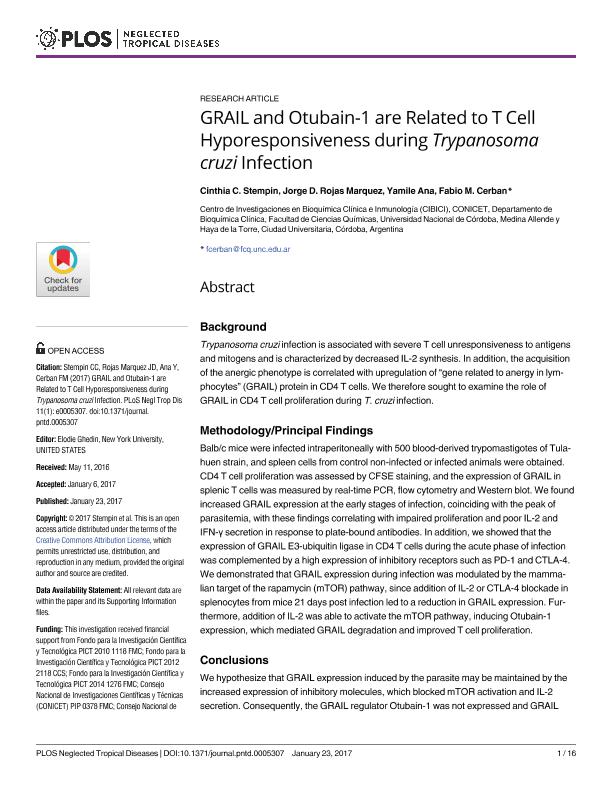Mostrar el registro sencillo del ítem
dc.contributor.author
Stempin, Cinthia

dc.contributor.author
Rojas Marquez, Jorge David

dc.contributor.author
Ana, Yamile

dc.contributor.author
Cerban, Fabio Marcelo

dc.date.available
2018-05-30T15:38:02Z
dc.date.issued
2017-01
dc.identifier.citation
Stempin, Cinthia; Rojas Marquez, Jorge David; Ana, Yamile; Cerban, Fabio Marcelo; GRAIL and Otubain are related to T cell hyporesponsiveness during Trypanosoma cruzi infection; Public Library of Science; PLoS Neglected Tropical Diseases; 11; 1; 1-2017
dc.identifier.issn
1935-2735
dc.identifier.uri
http://hdl.handle.net/11336/46616
dc.description.abstract
Trypanosoma cruzi infection is associated with severe T cell unresponsiveness to antigens and mitogens and is characterized by decreased IL-2 synthesis. On the other hand, acquisition of the anergic phenotype correlated with upregulation of gene related to anergy in lymphocytes (GRAIL) protein in CD4 T cells. We therefore sought to examine the role of GRAIL in CD4 T cell proliferation during T. cruzi infection.Methodology/Principal Findings We sought to examine the role of GRAIL in CD4 T cell proliferation during T. cruzi experimental infection. Balb/c mice were infected intraperitoneally with 500 blood derived trypomastigotes of Tulahuen strain, and spleen cells from control non-infected or infected animals were obtained. CD4 T cell proliferation was assessed by CFSE staining, and the expression of GRAIL in splenic T cells was measured by real-time PCR, flow cytometry and Western blot. We found an increased GRAIL expression at the early stages of infection, coincident with impaired proliferation and poor IL-2 and IFN- secretion in response to plate bound antibodies. In addition, we showed that the expression of GRAIL E3-ubiquitin ligase in CD4+ T cells during the acute phase of infection was complemented by a high expression of inhibitory receptors such as PD-1 and CTL-4. Moreover, we demonstrated that GRAIL expression during infection was regulated by IL-2 since it was able to activate the mammalian target of the rapamycin (mTOR) pathway, inducing Otubain-1 expression that mediated GRAIL degradation and improved T cell proliferation.
dc.format
application/pdf
dc.language.iso
eng
dc.publisher
Public Library of Science

dc.rights
info:eu-repo/semantics/openAccess
dc.rights.uri
https://creativecommons.org/licenses/by-nc-sa/2.5/ar/
dc.subject
T Cell
dc.subject
T.Cruzi
dc.subject
Grail
dc.subject
Mtor
dc.subject.classification
Inmunología

dc.subject.classification
Medicina Básica

dc.subject.classification
CIENCIAS MÉDICAS Y DE LA SALUD

dc.title
GRAIL and Otubain are related to T cell hyporesponsiveness during Trypanosoma cruzi infection
dc.type
info:eu-repo/semantics/article
dc.type
info:ar-repo/semantics/artículo
dc.type
info:eu-repo/semantics/publishedVersion
dc.date.updated
2018-05-29T20:55:05Z
dc.identifier.eissn
1935-2735
dc.journal.volume
11
dc.journal.number
1
dc.journal.pais
Estados Unidos

dc.journal.ciudad
San Francisco
dc.description.fil
Fil: Stempin, Cinthia. Consejo Nacional de Investigaciones Científicas y Técnicas. Centro Científico Tecnológico Córdoba. Centro de Investigaciones en Bioquímica Clínica e Inmunología; Argentina
dc.description.fil
Fil: Rojas Marquez, Jorge David. Consejo Nacional de Investigaciones Científicas y Técnicas. Centro Científico Tecnológico Córdoba. Centro de Investigaciones en Bioquímica Clínica e Inmunología; Argentina
dc.description.fil
Fil: Ana, Yamile. Consejo Nacional de Investigaciones Científicas y Técnicas. Centro Científico Tecnológico Córdoba. Centro de Investigaciones en Bioquímica Clínica e Inmunología; Argentina
dc.description.fil
Fil: Cerban, Fabio Marcelo. Consejo Nacional de Investigaciones Científicas y Técnicas. Centro Científico Tecnológico Córdoba. Centro de Investigaciones en Bioquímica Clínica e Inmunología; Argentina
dc.journal.title
PLoS Neglected Tropical Diseases

dc.relation.alternativeid
info:eu-repo/semantics/altIdentifier/url/https://bit.ly/2L9wd43
dc.relation.alternativeid
info:eu-repo/semantics/altIdentifier/doi/http://dx.doi.org/10.1371/journal.pntd.0005307
Archivos asociados
